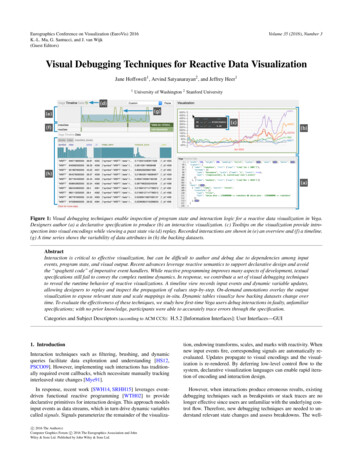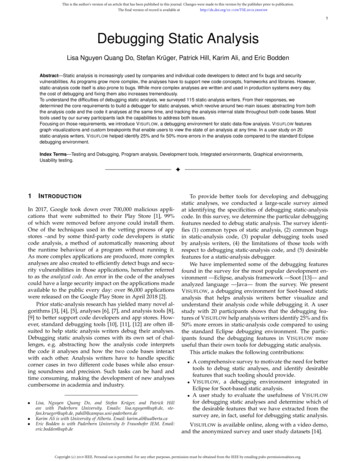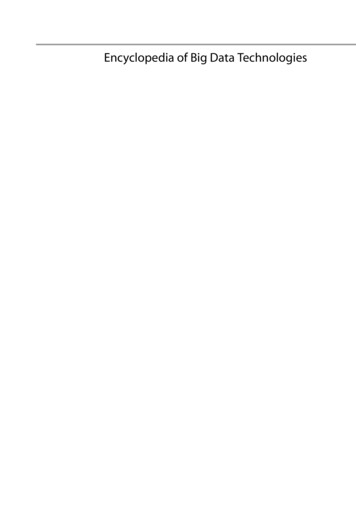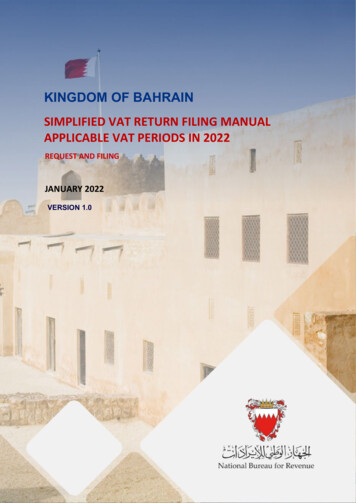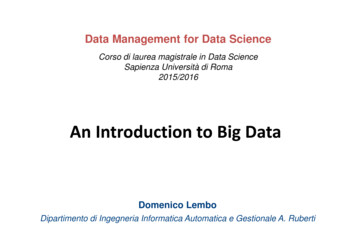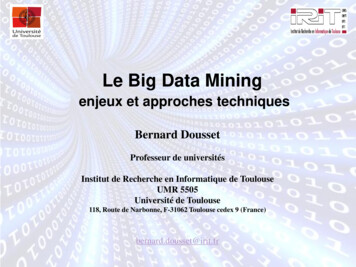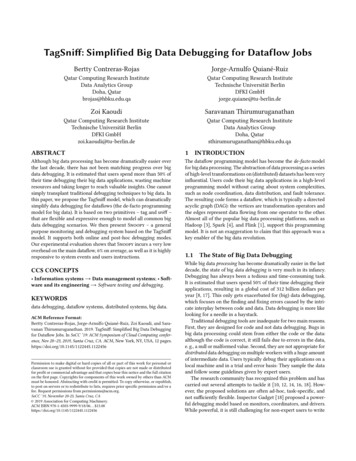
Transcription
TagSniff: Simplified Big Data Debugging for Dataflow JobsBertty Contreras-RojasJorge-Arnulfo Quiané-RuizQatar Computing Research InstituteData Analytics GroupDoha, Qatarbrojas@hbku.edu.qaQatar Computing Research InstituteTechnische Universität BerlinDFKI GmbHjorge.quiane@tu-berlin.deZoi KaoudiSaravanan ThirumuruganathanQatar Computing Research InstituteTechnische Universität BerlinDFKI GmbHzoi.kaoudi@tu-berlin.deQatar Computing Research InstituteData Analytics GroupDoha, gh big data processing has become dramatically easier overthe last decade, there has not been matching progress over bigdata debugging. It is estimated that users spend more than 50% oftheir time debugging their big data applications, wasting machineresources and taking longer to reach valuable insights. One cannotsimply transplant traditional debugging techniques to big data. Inthis paper, we propose the TagSniff model, which can dramaticallysimplify data debugging for dataflows (the de-facto programmingmodel for big data). It is based on two primitives – tag and sniff –that are flexible and expressive enough to model all common bigdata debugging scenarios. We then present Snoopy – a generalpurpose monitoring and debugging system based on the TagSniffmodel. It supports both online and post-hoc debugging modes.Our experimental evaluation shows that Snoopy incurs a very lowoverhead on the main dataflow, 6% on average, as well as it is highlyresponsive to system events and users instructions.The dataflow programming model has become the de-facto modelfor big data processing. The abstraction of data processing as a seriesof high-level transformations on (distributed) datasets has been veryinfluential. Users code their big data applications in a high-levelprogramming model without caring about system complexities,such as node coordination, data distribution, and fault tolerance.The resulting code forms a dataflow, which is typically a directedacyclic graph (DAG): the vertices are transformation operators andthe edges represent data flowing from one operator to the other.Almost all of the popular big data processing platforms, such asHadoop [3], Spark [4], and Flink [1], support this programmingmodel. It is not an exaggeration to claim that this approach was akey enabler of the big data revolution.CCS CONCEPTS Information systems Data management systems; Software and its engineering Software testing and debugging.KEYWORDSdata debugging, dataflow systems, distributed systems, big data.ACM Reference Format:Bertty Contreras-Rojas, Jorge-Arnulfo Quiané-Ruiz, Zoi Kaoudi, and Saravanan Thirumuruganathan. 2019. TagSniff: Simplified Big Data Debuggingfor Dataflow Jobs. In SoCC ’19: ACM Symposium of Cloud Computing conference, Nov 20–23, 2019, Santa Cruz, CA. ACM, New York, NY, USA, 12 ssion to make digital or hard copies of all or part of this work for personal orclassroom use is granted without fee provided that copies are not made or distributedfor profit or commercial advantage and that copies bear this notice and the full citationon the first page. Copyrights for components of this work owned by others than ACMmust be honored. Abstracting with credit is permitted. To copy otherwise, or republish,to post on servers or to redistribute to lists, requires prior specific permission and/or afee. Request permissions from permissions@acm.org.SoCC ’19, November 20-23, Santa Cruz, CA 2019 Association for Computing Machinery.ACM ISBN 978-1-4503-9999-9/18/06. . . RODUCTIONThe State of Big Data DebuggingWhile big data processing has become dramatically easier in the lastdecade, the state of big data debugging is very much in its infancy.Debugging has always been a tedious and time-consuming task.It is estimated that users spend 50% of their time debugging theirapplications, resulting in a global cost of 312 billion dollars peryear [8, 17]. This only gets exacerbated for (big) data debugging,which focuses on the finding and fixing errors caused by the intricate interplay between code and data. Data debugging is more likelooking for a needle in a haystack.Traditional debugging tools are inadequate for two main reasons.First, they are designed for code and not data debugging. Bugs inbig data processing could stem from either the code or the data:although the code is correct, it still fails due to errors in the data,e. g., a null or malformed value. Second, they are not appropriate fordistributed data debugging on multiple workers with a huge amountof intermediate data. Users typically debug their applications on alocal machine and in a trial and error basis: They sample the dataand follow some guidelines given by expert users.The research community has recognized this problem and hascarried out several attempts to tackle it [10, 12, 14, 16, 18]. However, the proposed solutions are often ad-hoc, task-specific, andnot sufficiently flexible. Inspector Gadget [18] proposed a powerful debugging model based on monitors, coordinators, and drivers.While powerful, it is still challenging for non-expert users to write
SoCC ’19, November 20-23, Santa Cruz, CAtheir debugging tasks using the proposed APIs. BigDebug [12]tried to re-think the traditional debugging primitives and proposedtheir corresponding big data brethren: simulated breakpoints andon-demand watchpoints. Nonetheless, it requires extensive modification to the data processing systems, incurs considerable overhead,and does not provide support for post-hoc debugging. Arthur [10]introduced the concept of selective replay as a powerful tool forenabling common debugging tasks, such as tracing and post-hoc debugging. However, replay-based debugging approaches are limitedto post-hoc debugging and hence do not support online debugging. Other works, such as Titian [14] and Newt [16], focus onefficiently implementing lineage for specific debugging tasks andhence cannot support a wider variety of debugging tasks.1.2Simplifying Big Data DebuggingBig data debugging is fundamentally very different from traditionalcode debugging. It thus requires a new suite of abstractions, techniques, and toolkits. In this paper, we make progress towards thiselusive goal: We introduce the TagSniff model, an abstract debugging model with two powerful primitives and present Snoopy, anefficient implementation of the TagSniff model.The TagSniff model. TagSniff is an abstract debugging modelthat is based on two primitives – tag and sniff – that are flexibleenough to allow users to instrument their dataflows for their sophisticated debugging requirements. The tag primitive attachesannotations (tags) as metadata to a tuple if the tuple satisfies theuser’s conditions. The sniff primitive is used for identifying tuplesrequiring debugging or further analysis based on either their metadata or values. The flexibility of these primitives stems from the factthat users can specify their requirements through UDFs. TagSniffalso comes with a set of convenience methods, which are syntacticsugar for users facilitating online and post-hoc debugging tasks.They internally use the tag and sniff primitives. We show that withTagSniff one can express most of the popular debugging scenarios.An efficient implementation of TagSniff. Snoopy implementsthe TagSniff model in Spark. It uses wrappers on the vertices of thedataflow and injected Spark operators in the edges of the dataflow.The wrappers annotate (using the tag primitive) tuples in thedataflow. The sniffers can pull (using the sniff primitive) relevantinformation out of the main dataflow for remotely debugging thedataflow job. The goals of Snoopy are: (i) provide the TagSniff abstraction for users to easily instrument their applications, (ii) allowa wide variety of debugging tasks, (iii) allow users to add customfunctionality for debugging data of interest, (iv) be as lightweightas possible to not affect the performance of the application dataflow,and (v) be portable to any underlying data processing system. Akey characteristic of Snoopy is its novel architecture that enablesboth in-place and out-of-place debugging. TagSniff is built on top ofRheem [7], a cross-platform system, and thus does not require anymodification of the underlying data processing platform.The rest of the paper is organized as follows. Section 2 discussesthe challenges and desiderata of big data debugging. Section 3introduces the TagSniff model. Sections 4 and 5 explain how onecan use the TagSniff model for online and post-hoc debugging.Sections 6 and 7 describe and evaluate Snoopy. Section 8 discussesrelated work and Section 9 concludes with final remarks.B. Contreras-Rojas, J.-A. Quiané-Ruiz, Z. Kaoudi, and S. Thirumuruganathan.2MOTIVATIONWe begin by enumerating the major debugging challenges encountered by programmers of big data applications when using traditional debugging approaches. We then discuss the changes neededfor two major debugging modes – online and post-hoc. By synthesizing various user studies [18, 23] and prior work [10–12, 20], weidentify the desiderata for big data debugging.2.1The Changing Face of DebuggingFrameworks like Spark have made big data processing much easier.However, big data debugging is still at its infancy. Suppose an analytic task on a terabyte of data failed to produce the expected results.There are two common, but ineffective, approaches to debuggingthis analytical task:(i) The first approach brings the tools developed for “small data”debugging to big data. So, one could attach a debugger to aremote Spark process and try the traditional mechanisms,such as issuing watchpoints, pausing the Spark runtime, andstepping the code line by line. This approach is expensive asit results in the pausing of the entire Spark runtime. Furthermore, due to the sheer size of the data, one cannot simplystep through the code and watch the intermediate results foreach tuple. Doing so is extremely time-consuming.(ii) The second approach tries to evaluate the task on a localmachine over a sample of the input dataset. This is based onthe fact that erroneous outputs are typically triggered by asmall fraction of data. Therefore, one could take a sample ofthe input dataset and evaluate it on a local machine. If thesample does not trigger the issue, try a larger sample andso on. Eventually, the data becomes too large to hold in asingle machine and/or use traditional debugging techniques.This approach is doomed to fail too.We make the following three observations:(1) Most of the bugs are often caused by the interplay betweencode and data. Traditional debugging tools are designed forcode debugging and not data debugging.(2) Traditional debugging tools are not appropriate for distributed debugging. Typical data processing jobs involvehundreds of tasks that are run on dozens of workers generating a huge amount of intermediate data.(3) Recent attempts for big data debugging are ad hoc, taskspecific and inflexible. There is a need for an abstractionthat can address the code-data distributed debugging whilehiding the internal complexity of the system.2.2Debugging ModesWe distinguish between two major modes, online and post-hoc, fordebugging big data jobs.Online mode. Online debugging happens when the main dataflowjob is still alive. Users can inspect intermediate results and do trialand-error debugging. Providing such verisimilitude is quite challenging as popular data processing systems operate in a batch mode.If one pauses the dataflow job, this could potentially pause the computation done by thousands of workers. This results into reducedthroughput and wastage of processing resources. Ideally, the online
TagSniff: Simplified Big Data Debugging for Dataflow JobsSoCC ’19, November 20-23, Santa Cruz, CATable 1: Desired debugging tasks.Debugging modeTaskOnlinecrash escriptionWhen a crash is triggered, return the tuple, the operator and the node that causedit.Allow the user to pause execution (virtually or truly) when a certain (user-defined)condition is met and step through, either to go the next tuple or to go to the nextoperator for the same tuple.Alert the user when a certain (user-defined) condition is met. Conditions can be ona single tuple, on a set of tuples or on a latency metric.Replay the execution of the entire or part of the main dataflow job.Forward or backward trace of tuples: given a tuple t, find all tuples that either stemfrom t (forward) or led to t (backward).Profile any kind of metric, such as data distribution, latency distribution, runtimeoverhead, and memory usage.Evaluate if the input or output tuples satisfy certain assertions, which is also usefulfor comparison with ground truth input/output tuples.Table 2: An example of tuple tags.mode should: (i) allow a user to inspect intermediate results withor without pausing the dataflow execution, and (ii) provide a setof primitives so that a user can select intermediate data relevantfor debugging programmatically. Very few systems [12] providesupport for online big data debugging.Post-hoc mode. This is the most common mode for big data debugging. Users instrument the main dataflow job to dump informationinto a log. One can then write another job (e. g., in Spark) to analyze the log and identify the issue. While common, this approachof using log files is often not sufficient. This is because a logicalview [12] is not available in the logs, such as which input recordsproduce a given intermediate result or the eventual output (i. e., lineage). This information is often invaluable for effective debugging.Ideally, the post-hoc mode should allow a user to (i) get the logicalview of the job without any effort and (ii) provide an easy way toexpress common post-hoc debugging scenarios. Very few systemsprovide extensive support for post-hoc debugging. Most of themsupport specific scenarios, such as lineage [16] or task replay [10],and cannot be easily generalized to others.2.3DesiderataCommon debugging tasks. Based on various user studies [18, 23]and prior work [10–12, 20], we identify the most popular debuggingtasks in Table 1 and grouped them in seven major categories. Veryfew systems can support all of them. Typically, the users roll theirsleeves and implement task-specific variants of these common tasksat a significant development cost.Desiderata for primitives. The requirements for primitives include (i) concise enough to handle the scenarios from Table 1, (ii) beflexible enough to handle customized debugging scenarios, (iii) provide support for both monitoring and debugging.Desiderata for a debugging system. To be an effective tool forbig data debugging, it must (i) provide holistic support for thedebugging primitives, (ii) handle common debugging scenarioswith no changes to the main dataflow job, (iii) allow users to addcustom functionality for identifying tuples of interest, (iv) havedetailed granularity at different levels (machine, dataset, and ionCaused the dataflow to failRequires online debuggingNeeds to be displayed to the userHas to be stored in a logRequires the dataflow execution to pauseNeeds to be tracked through the executionHas to skip the remaining transformationslevel), (v) have very low overhead to the main dataflow job, and(vi) be generic to common big data processing systems withoutmodifying them.3THE TAGSNIFF MODELWe introduce the tag-and-sniff debugging abstraction, TagSniff forshort. TagSniff provides the dataflow instrumentation foundationsfor supporting most online and post-hoc debugging tasks easilyand effectively. It is composed of two primitives, tag and sniff, thatoperate on the debug tuple. A unique characteristic of these primitives is that users can easily add custom debugging functionalityvia user defined functions (UDF). In the following, we call TagSniffsystem any system that implements this abstract debugging model.Example 1 (Running example: Top100Words). We consider the taskof retrieving the top-100 most frequent words. The following listingprovides the (slightly simplified) Spark code:1234valvalvalvaltw textFile.flatMap(l l.split(" "))wc tw.map(word (word, 1))wct wc.reduceByKey( )top100 wct.top(100)Listing 1: Top-100 frequent words (Top100Words).
SoCC ’19, November 20-23, Santa Cruz, CA3.1Debug TupleLet us first define the debug tuple on which our primitives operate.A debug tuple is the tuple1 that flows between the dataflow operators whenever debugging is enabled. For example, in Listing 1 ofExample 1, datasets tw, wc, wt, and top100 would contain debugtuples in debug mode. A debug tuple is composed of the originaltuple prefixed with annotations and/or metadata: tag1 tag2 ., tuple . Typically annotations describe how users expect thesystem to react, while metadata adds extra information to the tuples,such as an identifier. Table 2 illustrates an example set of annotations. For simplicity, we refer to both annotations and metadataas tags. Tags are inserted by either users or the debugging systemand mainly stem from dataflow instrumentation. The users canmanipulate these tags to support sophisticated debugging scenarios, e. g., lineage. To enable this tag manipulation, we provide thefollowing methods on the debug tuple: add tag (tag: String): Unit: takes as input a string value andappends it in the tags of the debug tuple. get tag (tag: String): String: returns all the tags that startwith the input string value. has tag (tag: String) : Boolean: takes as input a string valueand returns true if this value exists in the tags of the tuple. get all () : String: returns all the tags (annotations and metadata)of the debug tuple.For simplicity reasons, we henceforth refer to a debug tuplesimply as tuple.3.2Tag and Sniff PrimitivesOur guiding principle is to provide a streamlined set of instrumentation primitives that make common debugging tasks easy tocompose and custom debugging tasks possible. We describe theseprimitives below: tag (f: tuple tuple): It is used for adding tags to a tuple. Theinput is a UDF that receives a tuple and outputs a new tuple withany new tags users would like to append. A TagSniff system shouldthen react to such tags. sniff (f: tuple Boolean): It is used for identifying tuples requiring debugging or further analysis based on either their metadataor values. The input is a UDF that receives a tuple and outputs trueor false depending on whether the user wants to analyze this tupleor not. A TagSniff system is responsible for reacting to the sniffedtuples based on their tags.A TagSniff system can materialize this abstract model in manydifferent ways. We believe that two non-intrusive approaches forexposing the tag and sniff primitives is to specify them as annotations or additional methods in the dataflow. The system shouldthen handle these annotations or methods to convert them to theappropriate code. This results in very little intrusion in the maindataflow while still being easy to add.3.3ExamplesLet us now present a couple of debugging tasks whose instrumentation can be expressed with the TagSniff model without writing ahuge amount of boilerplate code.1Atuple is any kind of data unit, e. g., a line text or a relational tuple.B. Contreras-Rojas, J.-A. Quiané-Ruiz, Z. Kaoudi, and S. Thirumuruganathan.Example 2 (Data Breakpoint). Suppose the user wants to add a databreakpoint in Listing 1 for tuples containing a null value to furtherinspect them. She would then write the tag and sniff primitives asfollows:12tag(t if (t.contains(null)) t.add tag("pause"))sniff(t return t.has tag("pause"))Listing 2: Add a breakpoint in tuples with null values.Example 3 (Log). Suppose the user wants to log tuples that containnull values to be used for tracing later on. She would then need togenerate an identifier for each tuple and add it to the tuple’s metadata.This could be done in the tag primitive, while the sniff primitive wouldsimply detect such tuples. Notice that the user can use an externallibrary to generate her own tuple identifiers.12345tag(t if (t.contains(null)) {id Generator.generate id(t)t.add tag("id-" id)t.add tag("log")})sniff(t return t.has tag("log"))Listing 3: Log tuples with null values for tracing.The above two examples show that users can instrument theirdataflows using the tag and sniff primitives only, without writinghuge amount of boilerplate code.3.4DiscussionNote that, as our goal is to keep the model as simple as possible,we defined TagSniff at the tuple granularity only. The reader mightthen wonder how to use TagSniff on a set of tuples, i. e., taggingand sniffing a set of tuples that satisfies a certain condition. Thisis possible if the dataflow job itself contains an operator groupingtuples, such as reduce, group, or join. Otherwise, one would have tomodify the dataflow or create a new one to check if some conditionson a set of tuples hold. We consider this task as a data preparation/cleaning task, and not data debugging, and is thus out of the scopeof our framework. Still, one could do such checks with TagSniff ina post-hoc manner (i. e., after the dataflow execution terminates)as we will see in Section 5. To sum up, TagSniff is abstract enoughto be implemented at any granularity: from one tuple to a set oftuples; from one operator to a set of operators; from one worker toa set of workers.4ONLINE DEBUGGINGOnline debugging takes place while the job is still running. Thus,interactivity is crucial for online debugging as it allows users to(i) add breakpoints for data inspection, (ii) be notified with theappropriate information when a crash is triggered, and (iii) bealerted when certain conditions on the data are met. In contrast totraditional code debugging, interactivity in big data applications ismainly about the interplay between data and code. Therefore, newinteractivity functionalities are required.In the following, we demonstrate the power of TagSniff by describing how it can be used for the three scenarios above. In particular, we discuss how a TagSniff system should react to specific tagand sniff calls to support online debugging scenarios. We presenthow a user can debug a job in a post-hoc manner in the next section.
TagSniff: Simplified Big Data Debugging for Dataflow Jobs4.1Data BreakpointsDataflow jobs are typically specified as a series of operators thatperform pre-defined transformations over the datasets. That is,whenever an interesting tuple arrives and the dataflow pauses(either virtually or truly), a user would like to proceed by furtherinspecting how (i) an operator affects tuples, and/or (ii) a tuple istransformed by the rest of the dataflow. For this reason, we advocatetwo interactivity actions: next tuple and next operator.Next tuple by TagSniff. Suppose that the dataflow is paused onthe first tuple containing a null value by providing the tag andsniff functions of Listing 2. In other words, the user is interested ininspecting tuples containing a null value. Once the user has finishedinspecting a given tuple, one has to show the next tuple that matchesthe user defined constraints. Showing the next tuple in the datasetinstead – as done by traditional debugging – is not appropriate.We now describe how this functionality could be achieved usingTagSniff. Once a TagSniff system receives the next tuple instruction,it should remove the tag pause from that tuple and send it to thenext operator. This resumes the execution. The TagSniff systemwould then apply the tag and sniff function to the next incomingtuple in the inspected operator. If it satisfies the user condition (inthis case it contains a null value), the dataflow execution is pausedagain. This results in having the dataflow execution being resumedand paused at any tuple satisfying the tag conditions.Next operator by TagSniff. Suppose now the user wants to resume a paused dataflow by checking how the tuple, which causedthe dataflow to pause, is transformed by the downstream operators.Again, she can achieve this with the sniff function of Listing 2. ATagSniff system would simply propagate the tag pause togetherwith the tuple in order to pause the execution with the sniff function in the downstream operator. Thus, this functionality is relevantwhen users want to “follow” tuples and observe how they are beingtransformed by the operators in the dataflow.Interactivity convenience methods. To facilitate users whowant to use the next tuple and next operator tasks, we proposetwo convenience methods that a TagSniff system could provide: thenext tuple( ) and next operator( ). Internally, they instantiate thetag and sniff primitives as discussed above. Note that the systemcould expose these convenience methods to users via a debugginguser interface: a graphical one, where these methods are ideallyimplemented as built-in buttons, or as a command-line one.4.2Crash CulpritA crash culprit is a tuple that causes a system to crash. In a dataflowjob, a crash culprit causes an operator, and hence the entire dataflow,to crash. The objective is, thus, to identify not only the tuple butalso the operator and node where a runtime exception occurs.Crash culprit by TagSniff. Whenever a runtime exception occurs,a TagSniff system should catch the exception and invoke the tagprimitive. The latter annotates the tuple with the tag “crash” as wellas with the exception trace TRC, the operator id OID, and the nodeIP address. Then, the system invokes the sniff primitive to identifythis tuple by inspecting for the crash tag. Note that these tag andsniff instances are specified by the TagSniff system and not by theuser. We illustrate these two instances below:SoCC ’19, November 20-23, Santa Cruz, CA12tag(t t.add tag("crash-" TRC ":" OID ":" IP))sniff(t return t.has tag("crash"))Listing 4: Catch crash culprits.4.3AlertAn alert functionality notifies a user that a tuple satisfied somecondition of interest to the user. Users can add conditions on asingle tuple or set of tuples as well as on information computed atruntime, e. g., on a latency metric.Alert by TagSniff. Assume a user wants to be notified in theTop100Words example whenever there is a group of words thattakes too long to be processed as this can be a potential bottleneck.This is possible with a tag primitive that adds a timestamp to thetuple metadata. A TagSniff system should then call this primitivebefore and after a tuple is executed by the ReduceByKey operator.The sniff primitive would then retrieve the timestamp metadatafrom the debug tuple to get the first and second timestamps, compute the latency of the ReduceByKey invocation and check if it isabove some threshold. Listing 5 illustrates these primitives:123tag(t t.add tag("timestamp-" System.currentTimeMillis()))sniff(t {timestamps put in array(t.get tag("timestamp"))return (timestamps[1] - timestamps[0] THRESHOLD)})Listing 5: Identify performance bottlenecks.5POST-HOC DEBUGGINGPost-hoc debugging takes place on the execution logs once the maindataflow job finishes. As mentioned previously, simple executionlogs only provide a simplistic view where the input, intermediate,and output tuples are decoupled. Here, we describe how users canleverage the TagSniff primitives to produce much richer executionlogs with a logical view. Users can then analyze these logs to identifythe underlying issue. This calls for new querying functionalities thatfacilitate the analysis of rich execution logs. For example, obtaininglineage information or replaying a part of the dataflow executionfor a subset of tuples might require quite some coding expertise.Although TagSniff can support a wide variety of post-hoc debuggingtasks, our exposition focuses on how one can achieve each of thecommon post-hoc tasks listed in Table 1.Similar to the online debugging cases described in the previous section, here we discuss how a TagSniff system should reactto specific tag and sniff calls to support post-hoc debugging. Wealso introduce a set of convenience methods that prevent usersfrom writing many lines of code. There are many ways in which aTagSniff system could expose these post-hoc convenience methods.Depending on the dataflow language used by the user, these methods can be special keywords in case of a declarative language, suchas Pig Latin [19], or operators in case of a programmatic language.For example, one could write a Spark-like extension for these methods, which a TagSniff system should parse. We opted for the latterchoice. In the following, we thus present our illustrative examplesassuming the latter choice.5.1Forward and Backward TracingIntuitively, forward tracing allows users to identify which outputtuples were generated from a given input tuple. More generally, this
SoCC ’19, November 20-23, Santa Cruz, CAprocess allows users to understand how a given tuple is transformedby various operators in the dataflow. Conversely, backward tracingallows users to identify the input tuple(s) that generated a givenoutput tuple, which could be construed as a special case of lineage.Note that both forward and backward tracing could be executed onthe entire dataflow or a portion of it.Forward tracing with TagSniff. Suppose a user wants to trace aninput tuple throughout the entire dataflow if it contains an emptyword. Using the logs, the user can either run an ad-hoc dataflowor run the original dataflow properly instrumented with TagSniff.We argue the latter is much simpler. The tag primitive annotatesall tuples containing an empty value as trace, otherwise as skip. ATagSniff system would apply this tag function at the source operatorfollowed by a sniff function. This sniff function returns true forall tuples because each of them requires the system to act: eitherdisplay the tuple to the user (trace) or remove the tuple from thedataflow (skip). The TagSniff system wou
Almost all of the popular big data processing platforms, such as Hadoop [3], Spark [4], and Flink [1], support this programming model. It is not an exaggeration to claim that this approach was a key enabler of the big data revolution. 1.1 The State of Big Data Debugging While big data processing has become dramatically easier in the last

